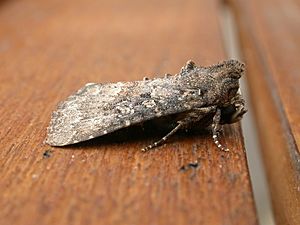Condica illecta facts for kids
Quick facts for kids Condica illecta |
|
|---|---|
 |
|
| Scientific classification | |
| Synonyms | |
|
The Condica illecta is a type of moth that belongs to the Noctuidae family, often called "owlet moths." These moths are found in warm, tropical parts of the world, including areas around India, Southeast Asia, and the Pacific Ocean. You can spot them in places like Borneo, Hawaii, Hong Kong, New Guinea, the Society Islands, Taiwan, and even in Queensland and New South Wales in Australia. They also live in New Zealand.
Contents
Discovering the Condica illecta Moth
This moth was first officially described by a scientist named Francis Walker in 1865. When scientists discover a new species, they give it a special two-part name, like Condica illecta. This helps everyone around the world know exactly which creature they are talking about.
What Does the Condica illecta Look Like?
The Condica illecta moth is a medium-sized moth. Its wingspan, which is the distance from the tip of one wing to the tip of the other when spread out, is about 40 millimeters (about 1.5 inches). This is roughly the length of a standard paperclip!
The adult moths are mostly brown. They have a pattern on their wings that isn't very clear or distinct, making it a bit tricky to spot them against backgrounds like tree bark or leaves. This helps them blend in and stay safe from predators.
The Life of a Condica illecta Larva
Like all moths, the Condica illecta starts its life as a tiny egg, which hatches into a larva. The larva is what we usually call a caterpillar. These caterpillars love to munch on different kinds of plants from the Asteraceae family. This plant family includes many common flowers like sunflowers and daisies. Some of their favorite snacks are:
- Ageratum houstonianum (also known as flossflower)
- Bidens pilosa (a common weed called "hairy beggarticks")
- Calendula officinalis (known as pot marigold)
How Larvae Change Their Appearance
The caterpillars of the Condica illecta go through some amazing changes as they grow.
- When they are young, they are smooth and green, with a brown head. This green color helps them hide among the leaves they eat.
- As they get older, they develop a cool purple pattern that looks a bit like a "herring-bone" design, and their head turns black.
- Finally, before they are ready to change into a moth, they turn brown. At this stage, they have a thin, wavy white line along each side of their body and some small white spots.
Once the caterpillar is fully grown, it moves into the soil to begin the next stage of its life cycle, called pupation. During pupation, the caterpillar transforms inside a protective casing, eventually emerging as an adult moth.

